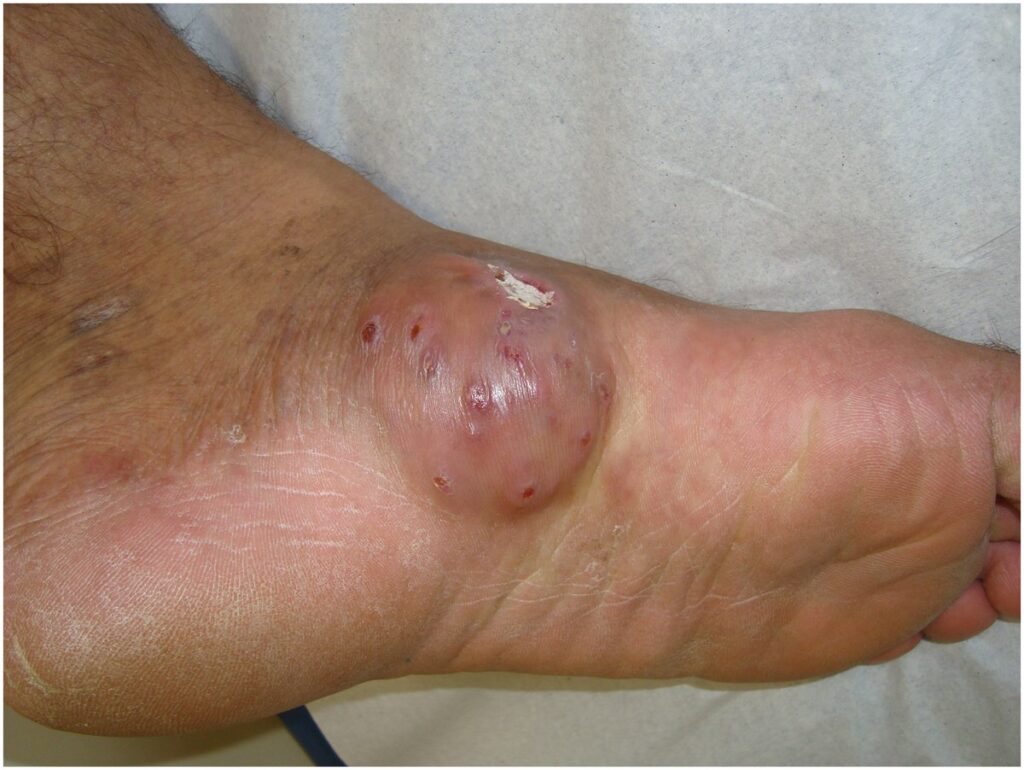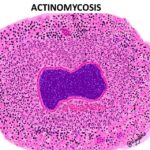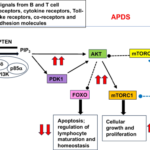Actinomycotic mycetoma is a chronic, progressive infection caused by actinomycetes, a group of filamentous bacteria. It primarily affects the skin, subcutaneous tissue, and occasionally deeper structures such as bones. This condition is characterized by swelling, sinus tract formation, and the discharge of granules, which are colonies of the causative bacteria. Understanding the pathogenesis, diagnosis, and treatment of actinomycotic mycetoma is essential for effective management and prevention.

What is Actinomycotic Mycetoma?
Actinomycotic mycetoma is a type of mycetoma, a chronic granulomatous disease. It is distinct from eumycetoma, which is caused by fungi. Actinomycotic mycetoma is endemic in tropical and subtropical regions and primarily affects individuals exposed to soil and organic matter. Farmers, laborers, and those in rural areas are at a higher risk due to their frequent contact with contaminated soil.
Key Characteristics
- Swelling: Progressive swelling at the site of infection.
- Sinus Tracts: Development of multiple draining sinuses that discharge seropurulent fluid.
- Granules: Presence of yellowish or whitish granules in the discharge, indicative of bacterial colonies.
Causes and Risk Factors of Actinomycotic Mycetoma
Causative Organisms
Actinomycotic mycetoma is caused by various species of actinomycetes, including:
- Nocardia spp.
- Streptomyces spp.
- Actinomadura spp.
These organisms are saprophytic bacteria found in soil and decaying vegetation.
Risk Factors
- Occupational Exposure: Farmers, gardeners, and construction workers are at greater risk.
- Trauma: Skin punctures from thorns or sharp objects provide an entry point for bacteria.
- Geographical Distribution: Prevalence is higher in regions with hot and humid climates, such as India, Africa, and Southeast Asia.
Clinical Manifestations of Actinomycotic Mycetoma
The symptoms of actinomycotic mycetoma develop gradually and may go unnoticed in the early stages. Key clinical signs include:
- Initial Lesion: A small, painless nodule or swelling that may resemble a boil.
- Progressive Swelling: Localized swelling expands over time, leading to deformity.
- Sinus Formation: Sinus tracts develop, discharging purulent fluid containing granules.
- Bone Involvement: In advanced stages, the infection may spread to underlying bones, causing osteomyelitis.
Diagnosis
Accurate diagnosis is critical for effective treatment. The diagnostic approach involves:
Clinical Evaluation
A thorough clinical examination focuses on characteristic swelling, sinus tracts, and granules in the discharge. Patient history, particularly occupational and environmental exposure, provides essential clues.
Microbiological Tests
- Microscopy: Examination of discharged granules under a microscope reveals bacterial filaments.
- Culture: Culturing the granules on specific media helps identify the causative organism.
Imaging
- X-rays: Useful in detecting bone involvement.
- Ultrasound: Identifies the extent of soft tissue damage.
- MRI: Provides detailed imaging of deeper structures affected by the infection.
Treatment Options
Treatment involves a combination of antimicrobial therapy and, in severe cases, surgical intervention.
Antimicrobial Therapy
Prolonged use of antibiotics is the cornerstone of treatment. Commonly used antibiotics include:
- Sulfonamides: Effective against Nocardia species.
- Amoxicillin-Clavulanate: Broad-spectrum activity against Actinomadura species.
- Combination Therapy: Combining antibiotics such as trimethoprim-sulfamethoxazole with amikacin may enhance efficacy.
Surgical Intervention
In cases where the infection is extensive or unresponsive to antibiotics, surgical debridement or amputation may be necessary to remove infected tissues.
Prevention of Actinomycotic Mycetoma
Preventive strategies focus on minimizing exposure and prompt treatment of initial wounds.
- Protective Gear: Wearing gloves and footwear reduces the risk of skin punctures.
- Hygiene: Immediate cleaning and disinfection of wounds prevent bacterial entry.
- Education: Awareness programs in endemic regions help individuals recognize early symptoms and seek timely treatment.
Actinomycotic mycetoma is a debilitating condition requiring early diagnosis and aggressive treatment to prevent severe complications. Understanding its clinical features, causative agents, and preventive measures is critical for managing this disease effectively. By adopting proactive prevention strategies and improving awareness, we can reduce the incidence and burden of actinomycotic mycetoma, particularly in endemic regions.
my health mag

